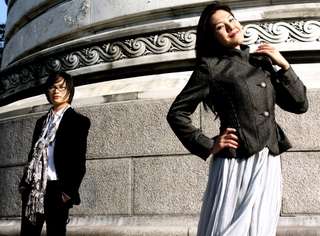|
Back
What’s In A Name? Unimaginable Riches! New York
Merkin Concerto Hall
06/20/2009 -
Claude Debussy: Nocturnes (Transcription for two pianos by Maurice Ravel)
John Corigliano: Kaleidoscope
Jose Bevia: Three Enigmas (World Premiere) (Digital artwork by Dean Radinovsky)
David Noon: Art Deco, Opus 64 (Video projection by Cyrus von Hochstetter)
Maurice Ravel: La Valse (Transcription for two pianos by the composer)
Ferdiko Piano Duo: Ferdy Tumakaka, Noriko Suzuki (Pianists), Presented by Distinguished Concerts International 
Ferdy Tumakaka, Norkiko Suzuki (© Eduard R. Lucas)
On a drizzly, soggy, miserable Saturday night, long lines formed outside the Merkin Concert Hall ticket window for a pair of pianists whose name formed a cute neologism, set to play three unfamiliar American works and two transcriptions of music which sounds good only with orchestra.
Did they know something I didn’t know? Emphatically yes, yes again yes. Within the first two amorphous measures of Debussy’s Nuages, the young nerdy-looking Ferdy Tumakaka and the gorgeously gowned Noriko Suzuki at two Steinways were, in a single word, electrifying.
I have heard duo-pianists many times, and been impressed by their coordination, artistry and how their temperaments merged. Tumakaka and Suzuki (okay, Ferdiko), both graduates of the Manhattan School of Music, were a single organism. Like two consorts of an orchestra, their temperaments were, yes, different. She was graceful, limpid, perfection personified. He was exciting, excitable, he would rise from his seat to whiz down the piano keyboard. But together, these two became a universal yin and yang, a feng shui energy without any obstacles.
The two French works were both transcribed by Maurice Ravel. He took no liberties with either (I didn’t recognize some of Mr. Tumakaka’s work in La Valse, but this could have been a harp glissando in the original). I did know that in La Valse all the excitement of the original, all the underlying waltz themes dominant, even as the keyboards imitated the orchestra.
The three American works started with John Corigliano’s sometimes jazzy Kaleidoscope dating from 1959, More than competent, it gave the two pianists chances to play in every possible genre. The second theme mirrored the end of Bernstein’s Candide, written a few years before. But even at the age of 21, Corigliano was so adept that he hardly needed to copy anyone else. The entire piece was great fun.
The world premiere of Jose Bevia’s Three Enigmas, written for Ferdiko, with three movements summing up their artistic personalities, was long but never boring. The opening was animated, vibrant, sometimes screaming up the piano keys; the next (based on Ms. Suzuki) had those pregnant pauses, those long pauses which were actually rather relaxing. It ended with a kind of infinite silence, the two temperaments coalescing into a single entity.
Three Enigmas was backed up by three pieces of digital artwork which frankly didn’t add (or detract) from the piece. The next, David Moon’s Art Deco used video projections by Cyrus von Hochstetter, which did reflect, with perfect changes to the musical changes, the four movements.
Port Alexander III showed abstracts of moving grasses, while the jazzy Rags were feet. The feet of the two pianists on the pedal, feet on New York streets. For the beautiful Lalique barely defined close-ups of eyes and mouth. Finally—to quote the previous two pieces—an enigmatic kaleidoscope of the ugliest industrial scenes around New York. Realistic factories, puddles, junk... and the final junk heap had, barely seen, a kitten trying to climb on a fence.
What did this have to do with the music? Mr. Moon, an artistic polymath who writes historical novels, teaches in China, publishes poetry and has written over 200 pieces of music, composed four interpretations of Art Deco, from Lalique glass (crystalline sounds), to American ragtime music, the discovery of African music (an insistent theme on the Ugandan “thumb piano”), and the rolling atmosphere of the first Art Deco exposition in 1925.
The main thing, though, was that these two pianists propelled all of their music forward with such excitement, seemingly spontaneous coordination and extremes of color that they could have been playing Chopsticks and it would have sounded good.
I’m trying to think of a single reservation about the concert, and all I can conceive is that they didn’t announce the title of their encore, a Wilder-style pop song writ with classical complexity.
Outside of that, the memory of this splendid concert made even the dismal drizzle almost delightful.
Harry Rolnick
|